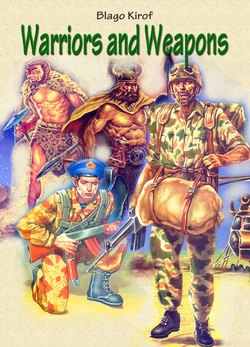Читать книгу Warriors and Weapons - Blago Kirof - Страница 3
На сайте Литреса книга снята с продажи.
Prehistoric Warfare
ОглавлениеThe Stone Age is a broad prehistoric period during which stone was widely used to make implements with a sharp edge, a point, or a percussion surface. The period lasted roughly 3.4 million years, and ended between 4500 BC and 2000 BC with the advent of metalworking. Stone Age artifacts include tools used by humans and by their predecessor species in the genus Homo, as well as the earlier partly contemporaneous genera Australopithecus and Paranthropus.
The Stone Age is further subdivided by the types of stone tools in use. Stone tools were made from a variety of stone. For example, flint and chert were shaped (or chipped) for use as cutting tools and weapons, while basalt and sandstone were used for ground stone tools, such as quern-stones. Wood, bone, shell, antler (deer) and other materials were widely used, as well.
Prehistoric warfare refers to war conducted in the era before writing, and before the establishments of large social entities like states. Historical warfare sets in with the standing armies of Bronze Age Sumer, but prehistoric warfare may be studied in some societies at much earlier dates.
At this stage, the mobilization of all male group members in a raiding party (as opposed to a hunting party) for the purpose of dawn raids on another group's sleeping quarters shifts the tactical advantage from defenders to attackers, capitalizing on the advantages of surprise and numerical superiority. Of the many cave paintings from the Upper Paleolithic, none depict people attacking other people.
The first archaeological record of what could be a prehistoric battle is at a Mesolithic site known as Cemetery 117. It was determined to be about 14,340 to 13,140 years old and located on the Nile near the Egypt-Sudan border. It contains a large number of bodies, many with arrowheads embedded in their skeletons, which indicates that they may have been the casualties of a battle.
Beginning around 12,000 BC, combat was transformed by the development of bows, maces, and slings. The bow seems to have been the most important weapon in the development of early warfare, in that it enabled attacks to be launched with far less risk to the attacker when compared to the risk involved in the use of mêlée combat weaponry. While there are no cave paintings of battles between men armed with clubs, the development of the bow is concurrent with the first known depictions of organized warfare consisting of clear illustrations of two or more groups of men attacking each other. These figures are arrayed in lines and columns with a distinctly garbed leader at the front. Some paintings even portray still-recognizable tactics like flankings and envelopments.
Warfare originated independently in other parts of the world as late as 4,000 years ago.[
